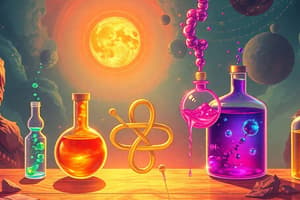Podcast
Questions and Answers
What is the purpose of stoichiometric calculations in chemical reactions?
What is the purpose of stoichiometric calculations in chemical reactions?
- To determine the equilibrium constant
- To determine the rate of reaction
- To identify the catalyst in the reaction
- To determine the amounts of reactants and products (correct)
Which reactant is completely consumed first in a chemical reaction?
Which reactant is completely consumed first in a chemical reaction?
- Limiting reagent (correct)
- Product
- Catalyst
- Excess reagent
What is the excess reagent in a chemical reaction?
What is the excess reagent in a chemical reaction?
- The product that is formed
- The reactant that is completely used up
- The reactant that is not completely used up (correct)
- The catalyst in the reaction
What is the formula for calculating percent yield?
What is the formula for calculating percent yield?
What does a high percent yield indicate in an industrial process?
What does a high percent yield indicate in an industrial process?
What is the main difference between molecular and empirical formulae?
What is the main difference between molecular and empirical formulae?
Why is identifying the limiting reagent crucial in stoichiometric calculations?
Why is identifying the limiting reagent crucial in stoichiometric calculations?
What is the significance of theoretical yield in stoichiometric calculations?
What is the significance of theoretical yield in stoichiometric calculations?
What is the first step in determining empirical and molecular formulae?
What is the first step in determining empirical and molecular formulae?
What is percent purity a measure of?
What is percent purity a measure of?
What is the formula for percent purity?
What is the formula for percent purity?
What is the purpose of titration?
What is the purpose of titration?
What is the relationship between the reactants in a titration expressed as?
What is the relationship between the reactants in a titration expressed as?
What is the final step in determining empirical and molecular formulae?
What is the final step in determining empirical and molecular formulae?
What is the purpose of finding the moles of each element in determining empirical and molecular formulae?
What is the purpose of finding the moles of each element in determining empirical and molecular formulae?
What is the term for the stoichiometric coefficients from the balanced equation in a titration?
What is the term for the stoichiometric coefficients from the balanced equation in a titration?
What is the purpose of finding the mass of each element in determining empirical and molecular formulae?
What is the purpose of finding the mass of each element in determining empirical and molecular formulae?
What is the significance of the simplest ratio in determining empirical and molecular formulae?
What is the significance of the simplest ratio in determining empirical and molecular formulae?
What is the advantage of using a standard solution of known concentration in titration?
What is the advantage of using a standard solution of known concentration in titration?
What is the result of dividing the given molar mass of the compound by the molar mass of the empirical formula?
What is the result of dividing the given molar mass of the compound by the molar mass of the empirical formula?
What is the purpose of calculating the molar mass of the empirical formula in determining molecular formulae?
What is the purpose of calculating the molar mass of the empirical formula in determining molecular formulae?
What is the role of the limiting reagent in a chemical reaction?
What is the role of the limiting reagent in a chemical reaction?
What is the requirement for the standard solution used in titration?
What is the requirement for the standard solution used in titration?
What is the result of multiplying the subscripts in the empirical formula by the multiplier?
What is the result of multiplying the subscripts in the empirical formula by the multiplier?
What is the theoretical yield in a chemical reaction?
What is the theoretical yield in a chemical reaction?
What is the relationship between the mass of the pure compound and the mass of the sample in calculating percent purity?
What is the relationship between the mass of the pure compound and the mass of the sample in calculating percent purity?
What is the purpose of calculating percent yield in a chemical reaction?
What is the purpose of calculating percent yield in a chemical reaction?
What is the empirical formula of a compound?
What is the empirical formula of a compound?
What is the significance of identifying the limiting reagent in stoichiometric calculations?
What is the significance of identifying the limiting reagent in stoichiometric calculations?
What is the relationship between the molecular and empirical formulae of a compound?
What is the relationship between the molecular and empirical formulae of a compound?
What is the effect of a high percent yield on an industrial process?
What is the effect of a high percent yield on an industrial process?
What is the purpose of comparing the mole ratios of the reactants to the ratios given by the balanced equation?
What is the purpose of comparing the mole ratios of the reactants to the ratios given by the balanced equation?
What is the purpose of finding the simplest ratio in determining empirical and molecular formulae?
What is the purpose of finding the simplest ratio in determining empirical and molecular formulae?
What is the result of dividing the moles of each element by the smallest number of moles obtained?
What is the result of dividing the moles of each element by the smallest number of moles obtained?
What is the significance of the multiplier in determining molecular formulae?
What is the significance of the multiplier in determining molecular formulae?
What is the purpose of calculating the molar mass of the empirical formula in determining molecular formulae?
What is the purpose of calculating the molar mass of the empirical formula in determining molecular formulae?
What is the relationship between the volumes of solutions A and B in a titration?
What is the relationship between the volumes of solutions A and B in a titration?
What is the significance of the mass of the pure compound in calculating percent purity?
What is the significance of the mass of the pure compound in calculating percent purity?
What is the purpose of using a standard solution of known concentration in a titration?
What is the purpose of using a standard solution of known concentration in a titration?
What is the result of dividing the given molar mass of the compound by the molar mass of the empirical formula?
What is the result of dividing the given molar mass of the compound by the molar mass of the empirical formula?
What determines the maximum amount of product that can be formed in a chemical reaction?
What determines the maximum amount of product that can be formed in a chemical reaction?
What is the purpose of calculating the mole ratios of the reactants in a chemical reaction?
What is the purpose of calculating the mole ratios of the reactants in a chemical reaction?
What is the significance of a low percent yield in an industrial process?
What is the significance of a low percent yield in an industrial process?
What is the difference between the molecular and empirical formulae of a compound?
What is the difference between the molecular and empirical formulae of a compound?
What is the result of dividing the actual yield of a product by the theoretical yield?
What is the result of dividing the actual yield of a product by the theoretical yield?
What is the purpose of identifying the excess reagent in a chemical reaction?
What is the purpose of identifying the excess reagent in a chemical reaction?
What is the significance of the mole ratio of the reactants in a chemical reaction?
What is the significance of the mole ratio of the reactants in a chemical reaction?
What is the advantage of a high percent yield in an industrial process?
What is the advantage of a high percent yield in an industrial process?
What is the primary purpose of calculating the moles of each element in determining empirical and molecular formulae?
What is the primary purpose of calculating the moles of each element in determining empirical and molecular formulae?
What is the significance of the multiplier in determining molecular formulae?
What is the significance of the multiplier in determining molecular formulae?
What is the primary purpose of titration in chemical analysis?
What is the primary purpose of titration in chemical analysis?
What is the relationship between the mass of the pure compound and the mass of the sample in calculating percent purity?
What is the relationship between the mass of the pure compound and the mass of the sample in calculating percent purity?
What is the primary purpose of finding the simplest ratio of the elements in determining empirical and molecular formulae?
What is the primary purpose of finding the simplest ratio of the elements in determining empirical and molecular formulae?
What is the relationship between the volumes of solutions A and B in a titration?
What is the relationship between the volumes of solutions A and B in a titration?
What is the primary purpose of calculating the molar mass of the empirical formula in determining molecular formulae?
What is the primary purpose of calculating the molar mass of the empirical formula in determining molecular formulae?
What is the significance of the stoichiometric coefficients in a titration?
What is the significance of the stoichiometric coefficients in a titration?
What is the primary reason for determining the limiting reagent in a chemical reaction?
What is the primary reason for determining the limiting reagent in a chemical reaction?
Which of the following is not a step in determining the empirical formula of a compound?
Which of the following is not a step in determining the empirical formula of a compound?
What is the significance of the mole ratio of the reactants in a chemical reaction?
What is the significance of the mole ratio of the reactants in a chemical reaction?
What is the result of dividing the actual yield of a product by the theoretical yield?
What is the result of dividing the actual yield of a product by the theoretical yield?
What is the relationship between the molecular and empirical formulae of a compound?
What is the relationship between the molecular and empirical formulae of a compound?
What is the purpose of calculating the mole ratios of the reactants in a chemical reaction?
What is the purpose of calculating the mole ratios of the reactants in a chemical reaction?
What is the significance of a high percent yield in an industrial process?
What is the significance of a high percent yield in an industrial process?
What is the purpose of comparing the mole ratios of the reactants to the ratios given by the balanced equation?
What is the purpose of comparing the mole ratios of the reactants to the ratios given by the balanced equation?




